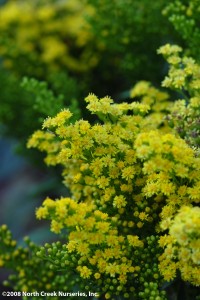Across the Southern Appalachian region (USDA zones 6 and 7), the native goldenrods (Solidago spp.) are easy to spot, growing 6-8 feet tall in ditch banks along roadsides and in the poorest of soils. Over the past quarter century short, more compact cultivars have arrived local garden centers.
‘Little Lemon’ grows only 12-15 inches tall with a 18-24 inch spread. This diminutive beauty is exceptionally compact with joyous light yellow flowers opening in late summer and blooming well into the fall season. ‘Little Lemon’ combines well with other autumnal pleasures such as asters, kales, and fall anemones either in garden beds or containers.
Goldenrods prefer moist, well-drained soils in full sun or partial shade, and are tolerant of wet sites. Plants possess good heat and drought tolerances. Fertilizing goldenrod is rarely needed, but likely will enhance plant vigor.
Goldenrods do not cause hay fever in the fall. The sticky oily goldenrod pollen is to heavy to be carried in the wind. Cut goldenrod flowers are long-lasting and used in dried arrangements.
Clumps need to be divided every 3-4 years. Birds and butterflies frequent flowers often and deer don’t graze on them.


 Posted in
Posted in 
